[English] 日本語
 Yorodumi
Yorodumi- PDB-5ctt: Crystal structure of human SART3/TIP110 NLS-mouse importin alpha ... -
+ Open data
Open data
- Basic information
Basic information
| Entry | Database: PDB / ID: 5ctt | ||||||
|---|---|---|---|---|---|---|---|
| Title | Crystal structure of human SART3/TIP110 NLS-mouse importin alpha complex | ||||||
 Components Components |
| ||||||
 Keywords Keywords | TRANSPORT PROTEIN / IMMUNE SYSTEM / NUCLEAR PROTEIN / RNA BINDING PROTEIN / Nuclear localization signal / Complex / Protein Transporter | ||||||
| Function / homology |  Function and homology information Function and homology informationU6atac snRNA binding / ASAP complex / regulation of RNA metabolic process / Sensing of DNA Double Strand Breaks / entry of viral genome into host nucleus through nuclear pore complex via importin / positive regulation of viral life cycle / NLS-dependent protein nuclear import complex / postsynapse to nucleus signaling pathway / U4 snRNA binding / nuclear import signal receptor activity ...U6atac snRNA binding / ASAP complex / regulation of RNA metabolic process / Sensing of DNA Double Strand Breaks / entry of viral genome into host nucleus through nuclear pore complex via importin / positive regulation of viral life cycle / NLS-dependent protein nuclear import complex / postsynapse to nucleus signaling pathway / U4 snRNA binding / nuclear import signal receptor activity / transcription elongation-coupled chromatin remodeling / hematopoietic stem cell proliferation / ubiquitin-specific protease binding / spliceosomal tri-snRNP complex assembly / homeostasis of number of cells / U6 snRNA binding / spliceosomal snRNP assembly / Cajal body / mRNA splicing, via spliceosome / cell morphogenesis / cytoplasmic stress granule / protein import into nucleus / nucleosome assembly / host cell / regulation of gene expression / protein-macromolecule adaptor activity / histone binding / DNA-binding transcription factor binding / postsynaptic density / nuclear speck / glutamatergic synapse / RNA binding / nucleoplasm / nucleus / cytoplasm / cytosol Similarity search - Function | ||||||
| Biological species |   Homo sapiens (human) Homo sapiens (human) | ||||||
| Method |  X-RAY DIFFRACTION / X-RAY DIFFRACTION /  SYNCHROTRON / SYNCHROTRON /  MOLECULAR REPLACEMENT / Resolution: 1.7 Å MOLECULAR REPLACEMENT / Resolution: 1.7 Å | ||||||
 Authors Authors | Park, J.K. / Kim, E.E. | ||||||
| Funding support |  Korea, Republic Of, 1items Korea, Republic Of, 1items
| ||||||
 Citation Citation |  Journal: Nucleic Acids Res. / Year: 2016 Journal: Nucleic Acids Res. / Year: 2016Title: Structural basis for recruiting and shuttling of the spliceosomal deubiquitinase USP4 by SART3 Authors: Park, J.K. / Das, T. / Song, E.J. / Kim, E.E. | ||||||
| History |
|
- Structure visualization
Structure visualization
| Structure viewer | Molecule:  Molmil Molmil Jmol/JSmol Jmol/JSmol |
|---|
- Downloads & links
Downloads & links
- Download
Download
| PDBx/mmCIF format |  5ctt.cif.gz 5ctt.cif.gz | 112.4 KB | Display |  PDBx/mmCIF format PDBx/mmCIF format |
|---|---|---|---|---|
| PDB format |  pdb5ctt.ent.gz pdb5ctt.ent.gz | 82.7 KB | Display |  PDB format PDB format |
| PDBx/mmJSON format |  5ctt.json.gz 5ctt.json.gz | Tree view |  PDBx/mmJSON format PDBx/mmJSON format | |
| Others |  Other downloads Other downloads |
-Validation report
| Summary document |  5ctt_validation.pdf.gz 5ctt_validation.pdf.gz | 442.6 KB | Display |  wwPDB validaton report wwPDB validaton report |
|---|---|---|---|---|
| Full document |  5ctt_full_validation.pdf.gz 5ctt_full_validation.pdf.gz | 447.6 KB | Display | |
| Data in XML |  5ctt_validation.xml.gz 5ctt_validation.xml.gz | 22.4 KB | Display | |
| Data in CIF |  5ctt_validation.cif.gz 5ctt_validation.cif.gz | 34.8 KB | Display | |
| Arichive directory |  https://data.pdbj.org/pub/pdb/validation_reports/ct/5ctt https://data.pdbj.org/pub/pdb/validation_reports/ct/5ctt ftp://data.pdbj.org/pub/pdb/validation_reports/ct/5ctt ftp://data.pdbj.org/pub/pdb/validation_reports/ct/5ctt | HTTPS FTP |
-Related structure data
| Related structure data |  5ctqC  5ctrC 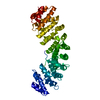 1ialS C: citing same article ( S: Starting model for refinement |
|---|---|
| Similar structure data |
- Links
Links
- Assembly
Assembly
| Deposited unit | 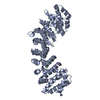
| ||||||||
|---|---|---|---|---|---|---|---|---|---|
| 1 |
| ||||||||
| Unit cell |
|
- Components
Components
| #1: Protein | Mass: 48446.379 Da / Num. of mol.: 1 / Fragment: UNP residues 72-497 Source method: isolated from a genetically manipulated source Source: (gene. exp.)   |
|---|---|
| #2: Protein | Mass: 6535.394 Da / Num. of mol.: 1 / Fragment: UNP residues 601-649 Source method: isolated from a genetically manipulated source Source: (gene. exp.)  Homo sapiens (human) / Gene: SART3, KIAA0156, TIP110 / Production host: Homo sapiens (human) / Gene: SART3, KIAA0156, TIP110 / Production host:  |
| #3: Water | ChemComp-HOH / |
-Experimental details
-Experiment
| Experiment | Method:  X-RAY DIFFRACTION X-RAY DIFFRACTION |
|---|
- Sample preparation
Sample preparation
| Crystal | Density Matthews: 3.17 Å3/Da / Density % sol: 65.97 % |
|---|---|
| Crystal grow | Temperature: 293 K / Method: vapor diffusion, hanging drop / Details: 100mM HEPES, pH 6.6, 1.6M sodium citrate, 10mM DTT |
-Data collection
| Diffraction | Mean temperature: 100 K |
|---|---|
| Diffraction source | Source:  SYNCHROTRON / Site: PAL/PLS SYNCHROTRON / Site: PAL/PLS  / Beamline: 5C (4A) / Wavelength: 0.9794 Å / Beamline: 5C (4A) / Wavelength: 0.9794 Å |
| Detector | Type: ADSC QUANTUM 315r / Detector: CCD / Date: Nov 5, 2012 |
| Radiation | Protocol: SINGLE WAVELENGTH / Monochromatic (M) / Laue (L): M / Scattering type: x-ray |
| Radiation wavelength | Wavelength: 0.9794 Å / Relative weight: 1 |
| Reflection | Resolution: 1.7→50 Å / Num. obs: 77648 / % possible obs: 99 % / Redundancy: 2.8 % / Rmerge(I) obs: 0.078 / Net I/σ(I): 19.8 |
| Reflection shell | Resolution: 1.7→1.76 Å / Redundancy: 2 % / Rmerge(I) obs: 0.453 / Mean I/σ(I) obs: 1.96 / % possible all: 97.4 |
- Processing
Processing
| Software |
| |||||||||||||||||||||||||||||||||||||||||||||||||||||||||||||||||||||||||||||||||||||||||||||||||||||||||
|---|---|---|---|---|---|---|---|---|---|---|---|---|---|---|---|---|---|---|---|---|---|---|---|---|---|---|---|---|---|---|---|---|---|---|---|---|---|---|---|---|---|---|---|---|---|---|---|---|---|---|---|---|---|---|---|---|---|---|---|---|---|---|---|---|---|---|---|---|---|---|---|---|---|---|---|---|---|---|---|---|---|---|---|---|---|---|---|---|---|---|---|---|---|---|---|---|---|---|---|---|---|---|---|---|---|---|
| Refinement | Method to determine structure:  MOLECULAR REPLACEMENT MOLECULAR REPLACEMENTStarting model: 1IAL Resolution: 1.7→37.765 Å / SU ML: 0.15 / Cross valid method: FREE R-VALUE / σ(F): 1.44 / Phase error: 21.42 / Stereochemistry target values: ML
| |||||||||||||||||||||||||||||||||||||||||||||||||||||||||||||||||||||||||||||||||||||||||||||||||||||||||
| Solvent computation | Shrinkage radii: 1.24 Å / VDW probe radii: 1.4 Å / Solvent model: FLAT BULK SOLVENT MODEL / Bsol: 36.684 Å2 / ksol: 0.341 e/Å3 | |||||||||||||||||||||||||||||||||||||||||||||||||||||||||||||||||||||||||||||||||||||||||||||||||||||||||
| Displacement parameters |
| |||||||||||||||||||||||||||||||||||||||||||||||||||||||||||||||||||||||||||||||||||||||||||||||||||||||||
| Refinement step | Cycle: LAST / Resolution: 1.7→37.765 Å
| |||||||||||||||||||||||||||||||||||||||||||||||||||||||||||||||||||||||||||||||||||||||||||||||||||||||||
| Refine LS restraints |
| |||||||||||||||||||||||||||||||||||||||||||||||||||||||||||||||||||||||||||||||||||||||||||||||||||||||||
| LS refinement shell |
|
 Movie
Movie Controller
Controller


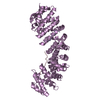
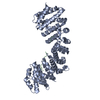
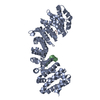
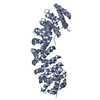
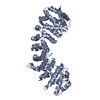
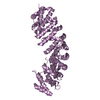
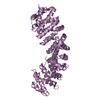
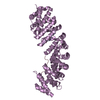
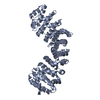
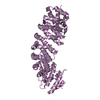

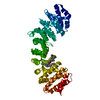
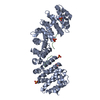
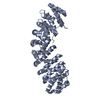

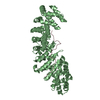
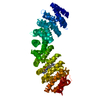
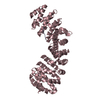
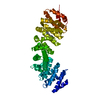
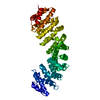
 PDBj
PDBj





